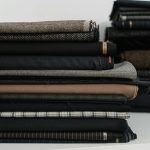So, you're faced with the classic dilemma: tweed or herringbone? Both fabrics have stood the test of time, each with its own unique charm and practicality.
In this deep dive, we'll explore the intricate details of these two iconic textiles. From their rich history to their distinct characteristics, we'll unravel the mystery behind their enduring appeal.
Whether you're a seasoned connoisseur or just delving into the world of fabrics, this comparison will equip you with the knowledge to make an informed choice.
Get ready to uncover the nuances of tweed and herringbone, and ultimately discover which fabric reigns supreme in the timeless debate.
Key Takeaways
- Both tweed and herringbone originated from Scotland and have historical and cultural significance.
- Tweed is known for its ruggedness and durability, while herringbone offers a more refined and versatile fabric.
- Tweed has a rough, woolen texture, while herringbone has a distinctive V-shaped pattern.
- Tweed exudes classic style and versatility, suitable for various occasions and settings.
History and Origins
When exploring the history and origins of tweed and herringbone, you may find that both fabrics have rich and distinct backgrounds.
Tweed, originating in Scotland, was initially handwoven with wool to withstand the harsh weather conditions, making it a practical and durable fabric for outdoor activities. Over time, tweed evolved from a protective garment for the working class to a symbol of wealth and sophistication, especially when popularized by British royalty and high society.
On the other hand, herringbone, with its origins traced back to the Roman Empire, derives its name from the resemblance of the weave to the skeleton of a herring fish. This fabric gained cultural significance and symbolism as it became associated with traditional British and American menswear, symbolizing timeless elegance and sartorial excellence.
The evolution of these fabrics reflects the historical and cultural contexts in which they originated, making them more than just materials; they're representations of tradition, craftsmanship, and societal values.
Characteristics and Durability
When choosing between tweed and herringbone, it's important to consider their durability and fabric characteristics.
Tweed is known for its sturdy and rugged nature, making it a reliable option for outerwear and heavy-duty garments.
On the other hand, herringbone offers a more refined and versatile fabric with a distinctive zigzag pattern.
Let's explore how these characteristics impact their durability and performance in various settings.
Tweed Vs Herringbone Durability
In comparing tweed versus herringbone for durability, you should consider the weave patterns and fiber compositions of each fabric.
Tweed, known for its durability, is woven with a rough, woolen fabric that enhances its resilience and longevity.
On the other hand, herringbone, with its distinctive V-shaped weaving pattern, also offers exceptional durability due to the way the fibers are interlaced, creating a strong and sturdy fabric.
When evaluating the durability comparison between tweed and herringbone, it's important to note that both fabrics excel in fabric performance, showcasing remarkable resistance to wear and tear. This makes them ideal choices for garments and upholstery that require enduring strength and longevity.
Ultimately, both tweed and herringbone are reliable and durable fabric options, ensuring long-lasting quality and performance.
- Tweed's robust woolen composition evokes a sense of reliability and endurance.
- Herringbone's intricate V-shaped weave pattern instills confidence in its strength and resilience.
- The exceptional durability of both fabrics assures lasting quality and performance, providing peace of mind for your clothing and upholstery needs.
Fabric Characteristics Compared
You frequently find yourself comparing the fabric characteristics and durability of tweed and herringbone.
Tweed patterns are known for their rough, woolen texture, which provides excellent insulation and wind resistance. The patterns in tweed often feature a combination of twill and herringbone weaves, adding depth and complexity to the fabric.
Herringbone weaves, on the other hand, create a distinctive V-shaped pattern that gives the fabric a sleek, sophisticated look.
In terms of durability, both tweed and herringbone are robust and long-lasting, making them ideal choices for outerwear and upholstery. Herringbone weaves, with their tight structure, offer a slightly smoother and denser finish compared to tweed patterns.
Understanding these fabric characteristics can help you make an informed decision when choosing between tweed and herringbone for your next project.
Style and Aesthetics
For a polished and timeless look, opt for tweed over herringbone. Tweed exudes a sense of classic style and comfort, making it a versatile choice for various occasions.
When considering color and pattern coordination, tweed offers a rich and textured appearance, allowing for effortless pairing with different hues and designs. Its intricate weave and earthy tones create a sophisticated aesthetic that conveys a sense of refinement and elegance.
Additionally, tweed fabric often evokes a feeling of warmth and coziness, making it an ideal choice for colder seasons, further enhancing its appeal. Furthermore, the distinct texture of tweed fabric adds depth and character to your outfit, elevating your overall style with a touch of sophistication.
The timeless appeal and adaptability of tweed make it a favored choice for those who seek a balance between traditional elegance and modern fashion. Incorporating tweed into your wardrobe allows for a seamless blend of sophistication and comfort, making it a fabric that stands the test of time.
Versatility and Application
Tweed's versatility makes it a practical choice for a range of settings and occasions, allowing you to effortlessly transition from casual to formal events with ease. Its adaptability sets it apart from herringbone, making it a go-to option for various application scenarios. Take a look at the versatility comparison in the table below:
| Application Scenarios | Tweed |
|---|---|
| Casual Events | Ideal for a relaxed yet stylish look. |
| Formal Occasions | Can be dressed up for a sophisticated appearance. |
| Outdoor Activities | Provides warmth and durability. |
| Professional Settings | Offers a polished and professional look. |
| Creative Environments | Allows for a touch of individuality and creativity. |
As depicted in the table, tweed excels in a wide range of application scenarios, making it a versatile choice for different settings. Whether you're attending a formal event, engaging in outdoor activities, or need a professional look, tweed has got you covered. Its adaptability and elegant appearance make it a solid option for mastering your style in various situations.
Maintenance and Care
Taking care of your tweed and herringbone garments is essential to maintaining their quality and appearance.
You'll want to know the best washing instructions for tweed, as well as effective stain removal tips.
Additionally, understanding the proper ironing techniques for herringbone will help you keep your clothing looking its best.
Washing Instructions for Tweed
Caring for your tweed involves following specific washing instructions to maintain its quality and longevity. When it comes to washing your tweed, it's essential to handle it with care to preserve its unique texture and durability. Here's how you can keep your tweed looking its best:
- Dry Clean or Alternative: For best results, consider dry cleaning your tweed to ensure that it's handled with the utmost care. If you prefer to avoid dry cleaning, look for alternative cleaning methods specifically designed for delicate fabrics.
- Gentle Cycle, Air Dry: If you choose to wash your tweed at home, use a gentle cycle with cold water and a mild detergent. After washing, avoid using the dryer and opt for air drying instead to prevent any potential damage to the fabric.
Following these washing instructions will help you maintain the timeless appeal of your tweed while ensuring its longevity.
Stain Removal Tips
To effectively handle stains on your tweed, employ gentle cleaning methods to preserve the fabric's integrity and appearance.
Begin by addressing stains promptly to prevent them from setting into the fabric. For liquid spills, blot the area with a clean cloth to absorb as much of the spill as possible. Avoid rubbing the stain, as this can further embed it into the fibers.
When dealing with solid stains, gently scrape off any excess material before treating the area. Always test any cleaning solution on a hidden area of the fabric to ensure it doesn't cause discoloration or damage.
For general fabric protection, consider using a fabric protector spray specifically designed for tweed to create a barrier against stains.
Herringbone Ironing Techniques
When ironing herringbone fabric, it's important to use low to medium heat to avoid damaging the delicate weave, continuing the careful maintenance and care required for tweed garments. Proper pressing is essential for maintaining the integrity of the herringbone pattern. Here are some ironing hacks to ensure your herringbone garments look their best:
- Steam Care: Use a handheld steamer to gently remove wrinkles without direct contact with the fabric, preserving the herringbone weave.
- *Emotion evoked: Confidence* – You'll feel more confident knowing you're using a gentle method that protects your garment.
- Pressing Cloth: Place a pressing cloth between the iron and the herringbone fabric to prevent shine and scorch marks.
- *Emotion evoked: Assurance* – This extra step provides assurance that your garment will remain pristine.
- Vertical Steaming: Hang the garment and use a vertical steamer to smooth out wrinkles, maintaining the fabric's texture.
- *Emotion evoked: Satisfaction* – Achieve satisfaction by effortlessly revitalizing your herringbone clothing.
Popularity and Trends
You'll notice that tweed has been gaining more popularity than herringbone in recent fashion trends. Fashion evolution has seen a resurgence of interest in tweed, with its versatile and timeless appeal. Tweed has become a favorite among consumers due to its durability, warmth, and texture. Its cultural significance, rooted in traditional British and Irish heritage, adds to its allure, reflecting a desire for timeless, quality pieces. Additionally, the textile industry trends have shown an increased focus on sustainable and natural materials, further boosting tweed's popularity.
On the other hand, while herringbone remains a classic choice, it has seen less of a resurgence in recent years. Consumer preferences have shifted towards more textured and visually interesting fabrics, contributing to the decline of herringbone's prominence in fashion trends. However, herringbone still holds a place of cultural significance, especially in menswear, and its timeless appeal ensures that it remains a staple in many wardrobes.
Frequently Asked Questions
Can Tweed or Herringbone Fabrics Be Easily Dyed or Customized to Different Colors and Patterns?
You can easily customize tweed or herringbone fabrics with different colors and patterns. The dyeing process allows for personalization, influenced by regional styles. Both fabrics offer versatility and can be tailored to your preferences.
Are There Any Cultural or Regional Associations With Tweed or Herringbone Fabrics That May Influence Their Use in Different Parts of the World?
Cultural influences and regional preferences play a significant role in the use of tweed and herringbone fabrics. Historical significance and fashion trends also contribute to their popularity in different parts of the world.
How Do Tweed and Herringbone Fabrics Compare in Terms of Their Environmental Impact and Sustainability?
When comparing tweed and herringbone fabrics, it's important to consider their environmental impact and sustainability. Tweed generally uses natural dyes and fibers, making it more environmentally friendly than herringbone, which often involves synthetic dyes and materials.
Are There Any Specific Industries or Professions Where Tweed or Herringbone Fabrics Are Particularly Popular or Preferred?
In certain professions and industries, tweed and herringbone fabrics are preferred due to their timeless appeal and associations with tradition and sophistication. Fashion preferences, regional associations, and customization options also play a role.
What Are Some Common Misconceptions or Myths About Tweed and Herringbone Fabrics That People Should Be Aware Of?
When it comes to tweed and herringbone fabrics, common misconceptions exist around their stiffness and limited dyeing options. However, these fabrics offer great customization opportunities and boast unique fabric characteristics that make them versatile and stylish.
- Recycling Nonwoven Fabrics: Is It Possible? - July 11, 2025
- Recycling Nonwoven Fabrics: Is It Possible? - July 11, 2025
- Recycling Nonwoven Fabrics: Is It Possible? - July 11, 2025







